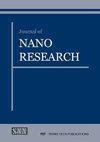不同油胺/聚乙烯吡咯烷酮用量对铂纳米颗粒形状的调制
IF 1
4区 材料科学
Q4 MATERIALS SCIENCE, MULTIDISCIPLINARY
引用次数: 1
摘要
通过调节溶液介质中油胺(OAm)与聚乙烯吡咯烷酮(PVP)的比例,研究了立方形状铂纳米颗粒(Pt NPs)的合成。OAm:PVP的质量比分别设置为1:2、1:1、2:1。以乙酰丙酮铂(Pt(acac)2)为Pt前驱体,采用微波辐照技术将其还原为金属Pt。结果表明,OAm用量的增加可促进立方形状Pt NPs的形成。Pt纳米粒子的平均尺寸在6 ~ 8 nm之间。将无负载Pt纳米粒子直接用作氧还原反应(ORR)的催化剂。根据催化剂的流体动力学ORR伏安图,在旋转圆盘电极(RDE)的所有搅拌速率下,以1:2 (OAm:PVP)制备的Pt NPs具有最高的电流密度。此外,基于电化学阻抗谱(EIS)分析,在0.9 V下,以2:1 (OAm:PVP)制备的Pt NPs具有最小的电荷转移电阻。在所有这些分析之后,我们使用额外的五种不同的(OAm:PVP)比例(1.5:1,1:1.5,2.5:1,3:1,1:3)合成了Pt NPs,以彻底检查ORR催化活性的最佳值。结果表明,以2.5:1 (OAm:PVP)比例制备的Pt NPs在所有催化剂中表现出最好的性能。本文章由计算机程序翻译,如有差异,请以英文原文为准。
Modulation of the Shape of Platinum Nanoparticles by Using Different Oleylamine/Polyvinylpyrrolidone Amounts
This study deals with the synthesis of cubic shape platinum nanoparticles (Pt NPs) by adjusting the oleylamine (OAm):polyvinylpyrrolidone (PVP) ratio in the solution media. The mass ratios between the OAm:PVP were respectively set to the 1:2, 1:1, 2:1 values. Platinum acetylacetonate (Pt(acac)2) was used as Pt precursor and the reduction of this salt to the metallic Pt was provided by microwave irradiation technique. It is seen that increasing amount of OAm triggers the formation of cubic shape Pt NPs. The average sizes of the Pt NPs fall in the range of 6-8 nm. The unsupported Pt NPs were directly used as a catalyst for the oxygen reduction reaction (ORR). According to the hydrodynamic ORR voltammograms of the catalysts, the Pt NPs prepared with 1:2 (OAm:PVP) exhibit the highest current density at all stirring rates of rotating disc electrode (RDE). Besides, Pt NPs prepared with 2:1 (OAm:PVP) have the minimum charge transfer resistance based on electrochemical impedance spectroscopy (EIS) analysis conducted at 0.9 V. After all these analyses, Pt NPs were synthesized using extra five different ratios (1.5:1, 1:1.5, 2.5:1, 3:1, 1:3) of (OAm:PVP) for thoroughly examining the optimum value for the ORR catalytic activity. As a result, the Pt NPs prepared with a 2.5:1 (OAm:PVP) ratio provided the best performance among all the catalysts.
求助全文
通过发布文献求助,成功后即可免费获取论文全文。
去求助
来源期刊

Journal of Nano Research
工程技术-材料科学:综合
CiteScore
2.40
自引率
5.90%
发文量
55
审稿时长
4 months
期刊介绍:
"Journal of Nano Research" (JNanoR) is a multidisciplinary journal, which publishes high quality scientific and engineering papers on all aspects of research in the area of nanoscience and nanotechnologies and wide practical application of achieved results.
"Journal of Nano Research" is one of the largest periodicals in the field of nanoscience and nanotechnologies. All papers are peer-reviewed and edited.
Authors retain the right to publish an extended and significantly updated version in another periodical.
 求助内容:
求助内容: 应助结果提醒方式:
应助结果提醒方式:


